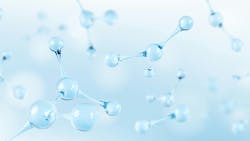Peptides: What are they, and how can they be used in dentistry?
What you'll learn in this article
- How peptides such as BPC-157, LL-37, and KPV modulate inflammation at the molecular level
- The dual role of BPC-157 in accelerating healing and reducing inflammation in both the oral cavity and gastrointestinal tract
- Clinical implications for periodontal therapy, implant integration, and mucosal healing
- Emerging evidence on the systemic benefits of peptides for broader tissue repair and recovery
What are peptides?
In the world of regenerative medicine and performance optimization, peptides have emerged as one of the most exciting breakthroughs. These short chains of amino acids—essentially the building blocks of proteins—act as signaling molecules in the body, instructing cells to repair, regenerate, or optimize specific functions. Beyond esthetics, peptides may play a crucial role in regenerative hard and soft tissue repair, metabolic control, weight management, and even long-term health.
As dental professionals, physicians, and wellness practitioners expand their scope into integrative health, understanding the science behind peptides can help us better educate patients and make informed decisions about adjunctive therapies. This article will focus on anti-inflammatory peptides that can be used to treat inflammation in both the mouth and stomach.
How can peptides decrease inflammation, thereby decreasing gum disease and gut problems?
Peptides such as BPC-157 (body protection compound 157), LL-37 (antimicrobial peptide LL-37), and KPV (a tripeptide fragment of alpha-MSH: Lys-Pro-Val) are gaining significant attention in functional medicine because of their potent anti-inflammatory properties. They work by modulating the immune response at a molecular level, helping to restore balance between pro-inflammatory and anti-inflammatory pathways. Although all these peptides work, the most amount of research to date has been on BPC-157.1
What is BPC-157?
BPC-157 is a synthetic peptide fragment derived from a naturally occurring protein in gastric juice. Its primary role is to accelerate healing, reduce inflammation, and promote angiogenesis (new blood vessel growth). Unlike many peptides, BPC-157 has strong stability in the acidic stomach environment, making oral formulations effective.
Mechanism of action in the mouth (oral cavity)
- Wound healing: Stimulates fibroblast activity, collagen synthesis, and keratinocyte migration, accelerating soft tissue repair (important for periodontal disease, oral ulcers, or mucosal trauma)2
- Anti-inflammatory modulation3: Reduces neutrophil and macrophage overactivation, limiting collateral damage to gum tissue
- Bone and ligament support: Early studies suggest BPC-157 promotes tendon-to-bone healing and osteogenesis, potentially relevant for periodontitis-related bone loss or implant integration.
- Neuroprotective role4: Modulates local nerve signaling, which may decrease neuropathic pain associated with chronic oral inflammation
Mechanism of action in the stomach (GI tract)5
- Mucosal protection: BPC-157 stabilizes and strengthens the gastric mucosal lining, helping prevent ulcers and tissue erosion.
- Nitric oxide modulation: It increases nitric oxide (NO) signaling, improving blood flow to gastric tissues and reducing ischemic injury.
- Anti-inflammatory effects: Downregulates pro-inflammatory cytokines (IL-6, TNF-α, IL-1β) and reduces oxidative stress
- Gut barrier integrity: Promotes repair of tight junctions, limiting “leaky gut” and preventing translocation of inflammatory molecules
- Angiogenesis and collagen production: Enhances growth of new blood vessels and collagen fibers, accelerating tissue repair after injury or chronic inflammation
How BPC-157 decreases inflammation3
- Suppresses pro-inflammatory pathways: Inhibits NF-κB signaling, reducing the cascade of inflammatory cytokines
- Enhances anti-inflammatory factors: Upregulates protective growth factors such as VEGF (vascular endothelial growth factor) and TGF-β
- Reduces oxidative stress: Neutralizes reactive oxygen species (ROS), decreasing tissue damage in the inflamed oral mucosa or stomach lining
- Restores tissue balance: Unlike broad anti-inflammatories (NSAIDs), BPC-157 doesn’t shut down inflammation entirely; it rebalances immune activity to promote controlled healing.
Clinical implications
- Oral health: May accelerate recovery in periodontal surgery, mucosal ulcerations, and implant integration by reducing inflammation and promoting tissue repair. More studies are needed in this area.
- Gastrointestinal health: Protects against gastric ulcers, inflammatory bowel disease, and damage from NSAIDs or alcohol
- Systemic effect: Because of its stability and signaling capacity, oral BPC-157 may also support systemic healing in joints, tendons, and nerves.
Conclusion
Oral BPC-157 decreases inflammation in the mouth and stomach by repairing mucosal barriers, modulating cytokines, reducing oxidative stress, and promoting angiogenesis and collagen synthesis. This dual effect makes it a promising peptide for both dental and gastrointestinal healing.
Editor’s note: This article originally appeared in Perio-Implant Advisory, a chairside resource for dentists and hygienists that focuses on periodontal- and implant-related issues. Read more articles and subscribe to the newsletter.
References
- Józwiak M, Bauer M, Kamysz W, Kleczkowska P. Multifunctionality and possible medical application of the BPC 157 peptide–literature and patent review. Pharmaceuticals (Basel). 2025;18(2):185. doi:10.3390/ph18020185
- Gwyer D, Wragg NM, Wilson SL. Gastric pentadecapeptide body protection compound BPC 157 and its role in accelerating musculoskeletal soft tissue healing. Cell Tissue Res. 2019;377(2):153-159. doi:10.1007/s00441-019-03016-8
- Keremi B, Lohinai Z, Komora P, et al. Antiinflammatory effect of BPC 157 on experimental periodontitis in rats. J Physiol Pharmacol. 2009;60(Suppl 7):115-122.
- Jung YH, Kim H, Kim H, Kim E, Baik J, Kang H. The anti-nociceptive effect of BPC-157 on the incisional pain model in rats. J Dent Anesth Pain Med. 2022;22(2):97-105. doi:10.17245/jdapm.2022.22.2.97
- Sikiric P, Seiwerth S, Rucman R, et al. Brain-gut axis and pentadecapeptide BPC 157: theoretical and practical implications. Curr Neuropharmacol. 2016;14(8):857-865. doi:10.2174/1570159x13666160502153022
About the Author

Scott Froum, DDS
Editorial Director
Scott Froum, DDS, a graduate of the State University of New York, Stony Brook School of Dental Medicine, is a periodontist in private practice at 1110 2nd Avenue, Suite 305, New York City, New York. He is the editorial director of Perio-Implant Advisory and serves on the editorial advisory board of Dental Economics. Dr. Froum, a diplomate of both the American Academy of Periodontology and the American Academy of Osseointegration, is a volunteer professor in the postgraduate periodontal program at SUNY Stony Brook School of Dental Medicine. He is a PhD candidate in the field of functional and integrative nutrition. Contact him through his website at drscottfroum.com or (212) 751-8530.
